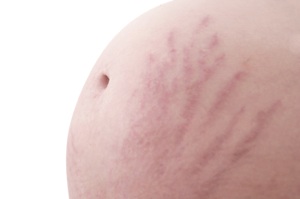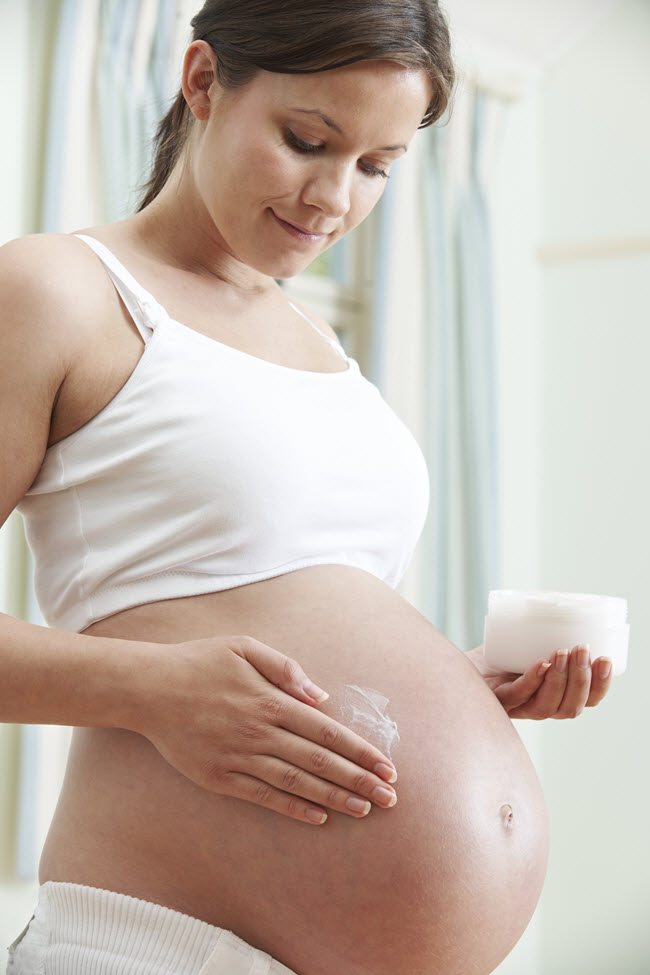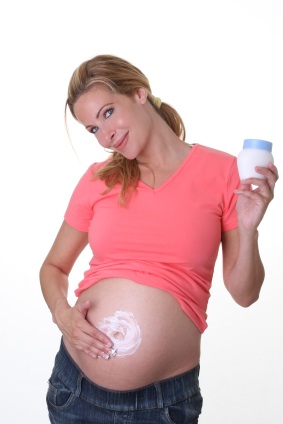Stretch marks are visible blemishes that can develop anywhere on a person’s skin. They usually occur when the skin has been stretched because of pregnancy, weight gain or any other reason. Stretch marks affect people of all ages and genders; however, they most particularly affect pregnant mothers.
Alternative Names
The blemishes are most commonly referred to, by both doctors and patients, as “stretch marks”. However, there are several, much more technical, names that refer to this condition. Dermatologists most often refer to stretch marks as “singular stria” or “striae”. Other medical names for this condition include stria destensae, vergetures, lineae atrophicae, and linea albicante. Striae gravidarum is the term that refers to the stretch marks that pregnant women develop.

Symptoms
Stretch marks are thin, wavy lines of any length that appear on a person’s skin. When the marks first appear, they will often be dark red or even purple. The color usually fades with time; in fact, stretch marks can eventually fade to the extent that they only have a slight difference in pigmentation from the rest of the skin.
Although the marks can occur anywhere on a person’s body, they most often develop in places that store excess fat and, particularly in girls, in places that mature at puberty.
Common areas include the thighs, hips, and upper arms. They can also occur on the buttocks and around the knees. Stretch marks will often appear around the breasts of maturing girls. Pregnant women are almost guaranteed to develop abdomen stretch marks (medically known as striae gravidarum) by the beginning of their third trimester.
Stretch Marks? Get Remedies Fast!
Causes
Stretch marks can occur when a person’s levels of glucocorticoid hormones are raised. These hormones keep the fibroblasts of the skin from forming elastin fibers and collagen, which are two of the skin’s most supportive components. The raised levels can be caused by several factors including weight gain, diet, and common hormonal imbalances. If the skin of a person with too many glucocorticoids is stretched, he or she is almost guaranteed to develop stretch marks.
However, a person can develop stretch marks even if he or she does not have too many glucocorticoids. Anything that causes the skin to stretch will often leave marks. Pregnancy is the most common cause. Other common causes include weight gain and, particularly in girls, puberty. Stretch marks can also be caused by hormone replacement therapy for either menopause treatments or transsexual operations.
Risk Factors
In general, stretch marks do not have any risk factors except, perhaps, loss of self confidence.
Prevention Tips
Unfortunately, stretch marks that occur because of puberty or weight gain cannot be prevented. If treatments are begun the moment the marks appear, their severity may be lessened.

Many dermatologists recommend that pregnant women daily apply a cream with vitamin E to their abdomen. The same recommendation is often made to those who are undergoing hormone replacement therapy.
Treatment Options
Natural and/or Home Remedies
Unfortunately, most natural and/or home remedies will not completely eliminate stretch marks. However, they are much more cost effective as well as much safer than surgeries or chemical options.
Cocoa Butter
For decades, cocoa butter has been considered the number one blemish remover. However, recent studies have shown that, although it is a very good moisturizer, it does not remove or prevent stretch marks, scars, or any other blemishes. Cocoa butter does not, however, cause any adverse effects unless, of course, the person using it is allergic to it. Some people still claim that cocoa butter has lightened their blemishes. Therefore, it is perfectly safe and logical if a person wants to give it a try.
Gotu Kola
Gotu Kola, which is the more common name for centella asiatica, is an ancient Chinese herb. In the ancient world, it was used to treat a number of illnesses and skin maladies, including leprosy. One of the herb’s modern uses is to reduce and/or prevent stretch marks. Dermatologists recommend that a cream with Gotu Kola extract and vitamin E be applied daily before and/or after stretch marks appear. It is particularly recommended for pregnant women and others who can predict the development of stretch marks.
Vitamin E
Vitamin E treats every skin problem, including stretch marks. It can be applied topically or taken as a dietary supplement. When used topically, it is recommended to use either pure vitamin E oil or a mixture that includes Gotu Kola. Those taking a dietary supplement should take approximately 400 IUs per day. Vitamin E oil, soft gels, and other products can be purchased, at a reasonable cost, at nearly every health store as well as from online suppliers.
Vitamin E, in any form, should not cause any adverse effects.
Vitamin K
Although it is not the most recommended treatment, vitamin K can help reduce stretch marks. It is best to apply a 5% vitamin K cream, once or twice a day. The only likely side effect is mild skin irritation.
Zinc
Zinc is one of the few remedies that have actually been proven to prevent the development of stretch marks. Zinc creams can be topically applied and there are also several zinc dietary supplements that are highly effective. Adults should not ingest more than 50 mg of zinc per day. Children should not ingest more than 30 mg. It is advisable to speak to a medical professional before zinc is administered to young children and infants.
If taken in excess, zinc can be toxic. Also, although it is unlikely, zinc creams may cause mild skin irritation.
Aloe Vera
Aloe vera can help prevent stretch marks as well as lighten those that already exist. Aloe vera is an ancient plant from Northern Africa. It is used to treat several conditions and can be purchased in several forms. The most popular forms, however, are pure aloe vera extracts and gels.

When treating stretch marks, aloe vera should be applied generously once or twice a day. The only adverse effect it may cause is mild skin irritation that should cease the moment use is stopped. There are many lotions and creams that include aloe vera; however, it will only effectively treat stretch marks if it is applied in large amounts. Also, other ingredients mixed with aloe vera can increase the risk of skin irritation.
Aloe vera capsules and tinctures will have absolutely no effect on stretch marks.
Olive Oil
Although olive oil cannot prevent stretch marks, it can help them to fade after they develop. The oil is rich in vitamins A, D, and E, and has been proven effective in treating many skin problems including acne, eczema, and scarring.
When treating stretch marks, extra virgin olive oil should be applied generously once a day. It is recommended to make a mixture of olive oil and pure aloe vera. Olive oil can also be taken orally although it will not be as effective as when applied topically. Caution should be used because, if large amounts of olive oil are ingested, it can act as a laxative. If the oil is applied topically, it should not cause any adverse effects except, perhaps, mild skin irritation.
Alpha Hydroxy Acid
Alpha hydroxy acid, AHA for short, is a very common, over-the-counter skin care product. It comes in a variety of forms including sprays, gels, and creams. Although most AHA products are available over-the-counter, some, particularly those that are extremely powerful, must be prescribed by a dermatologist.
AHA is, for the most part, perfectly safe. However, it may cause skin irritation such as peeling and blistering.
Also, long term use can lead to photosensitivity.
Pharmaceuticals
Prescription Retinoids
Retinoids are used to treat acne, psoriasis, stretch marks, and several other skin conditions. They are most often prescribed by a dermatologist and they come in several forms including pills, gels, and creams.
Retinoids have been approved by the FDA. However, caution should be used because they can cause several extremely serious conditions: in addition to mild or severe skin irritation, retinoids can cause hair loss, bleeding, skin lesions, papilledema (swelling of the optic disc), and hepatosplenomegaly (simultaneous enlargement of the spleen and the liver).
Surgeries
Because the only surgeries for stretch marks are cosmetic procedures, they will usually not be covered by medical insurance. It is unfortunate because most of these procedures are extremely expensive.
Fractional Laser Resurfacing Surgery
Fractional laser resurfacing surgery is particularly recommended to remove stretch marks caused by pregnancy. Laser surgery slowly removes blemishes and/or unwanted skin layer by layer. The procedure usually takes less than an hour and can cost anywhere from $900 to $1,200. Unfortunately, the results are not permanent. When the stretch marks return, the procedure will need to be repeated.
Fractional laser resurfacing surgery can cause several side effects, including swelling, scarring, infection, and changes in pigmentation. This procedure cannot remove extremely deep stretch marks.
Abdominoplasty
Abdominoplasty is a cosmetic procedure that removes excess fat and muscle as well as unwanted skin from the abdomen. It has been nicknamed “tummy tuck”. This procedure can be used to remove stretch marks on the abdomen, particularly those that develop because of pregnancy. An abdominoplasty costs approximately $5,000.
In general, abdominoplasty is considered a safe procedure. It can cause several side effects including abdominal pain and swelling. Unfortunately, these symptoms can last as long as six weeks after surgery.
Other Treatments
Microdermabrasion
Microdermabrasion, often referred to simply as Microderm, is a popular “spa treatment”. During this procedure, a person’s skin is “sanded” with different materials including several types of crystal. Microdermabrasions are usually administered by a dermatologist or a plastic surgeon. The procedure is, for the most part, painless; however, some patients request a light anesthesia.
The procedure is not recommended for children under the age of 14. A physician should be consulted if a person suffers from rosacea, eczema, or any other skin condition. Microdermabrasions can cause skin irritation particularly if a person is allergic to an ingredient used during the procedure. Another possible side effect is changes in pigmentation; in some rare cases, microdermabrasions have caused the skin condition hyperpigmentation.
Microdermabrasions can cost anywhere from $80 to $150 per treatment. Unfortunately, it is very rare for stretch marks to be eliminated after just one Microdermabrasion treatment. There are kits that allow the person to perform the procedure at home; however, they are not recommended because of the possible danger involved.
Chemical Peels
Chemical peels can be used to lessen, if not eliminate, stretch marks. There are several different types of peels, some of which will not effectively remove stretch marks. It is best to use either an alpha hydroxy acid peel or a trichloroacetic acid peel. Both of these peels can cause skin sensitivity and, if not done properly, may cause scarring.
Although many chemical peel solutions can be purchased over-the-counter, it is recommended, particularly when using peels with trichloroacetic acid, that they be administered by a dermatologist, a medical doctor, or some other qualified professional. Chemical peels administered by a doctor usually cost anywhere from $100 to $600 per treatment. The severity of the condition as well as the type of peel used can make multiple treatments necessary.

1 Comment
hey this was great,defenitly going be looking out for products with vitamin E in. just a question, is there a lazer surgery that will remove/fade stretch marks? thanks, bethany.